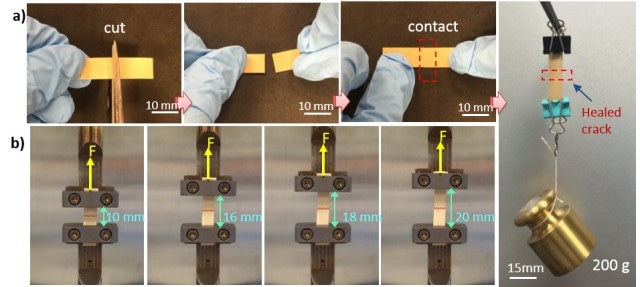May 17 2016
 Researchers have developed a flexible electronic material that self-heals to restore many functions, even after multiple breaks. Here, the material is shown being cut in half. The healed material is still able to be stretched and hold weight. (Image: Qing Wang / Penn State)
Researchers have developed a flexible electronic material that self-heals to restore many functions, even after multiple breaks. Here, the material is shown being cut in half. The healed material is still able to be stretched and hold weight. (Image: Qing Wang / Penn State)
Electronic materials are the main tentative block for the development of flexible electronics as current materials do not work properly once broken and healed. An international team of researchers developed a new electronic material, which can heal all of its functions spontaneously even after being broken numerous times. This material can increase the strength of wearable electronics.
Wearable and bendable electronics are subject to mechanical deformation over time, which could destroy or break them. We wanted to find an electronic material that would repair itself to restore all of its functionality, and do so after multiple breaks.
Qing Wang, Professor of Materials Science and Engineering, Penn State
Self-healable materials are those that can naturally restore themselves with minimum or no external effect after enduring physical deformation, such as being broken in half.
Scientists have previously created self-healable materials that could bring back one function after being broken, however restoring a group of functions is important to develop operative wearable electronics. For instance, if a dielectric material is able to retain its electrical resistivity but not thermal conductivity after self-healing, it could lead to electronics overheating.
The material which Wang and his research team developed restores all of the properties required to be used as dielectric in wearable electronics - breakdown strength to protect against surges, mechanical strength, thermal conductivity, electrical resistivity and dielectric, or insulating, properties. Their findings were published online in Advanced Functional Materials.
Wang informed that almost all self-healable materials are soft or "gum-like,", but the material which he and his associates produced is very hard in comparison. His group took a base material of plastic polymer and added boron nitride nanosheets to it. Similar to graphene, boron nitride nanosheets are also two dimensional, but they repel and insulate against it instead of conducting electricity like graphene.
Most research into self-healable electronic materials has focused on electrical conductivity but dielectrics have been overlooked. We need conducting elements in circuits but we also need insulation and protection for microelectronics.
Qing Wang, Professor of Materials Science and Engineering, Penn State
The material is able to heal by itself as boron nitride nanosheets link with one another using hydrogen bonding groups functionalized on their exterior. When two pieces are located closed to each other, the electrostatic attraction spontaneously occurring among both of the bonding elements brings them close together. Once the hydrogen bond is brought back, both the pieces are "healed." Based on the amount of boron nitride nanosheets added to this polymer, self-healing may need extra pressure or heat, nonetheless some forms of the novel material can heal by itself at room temperature when placed close to each other.
In contrast to other healable materials, which utilize hydrogen bonds, boron nitride nanosheets are resistant to moisture. This indicates that instruments employing the dielectric material can effectively function within high humidity situations like at a beach or in a shower.
This is the first time that a self-healable material has been created that can restore multiple properties over multiple breaks, and we see this being useful across many applications.
Qing Wang, Professor of Materials Science and Engineering, Penn State
Lixin Xing, Penn State and Harbin Institute of Technology; Qi Li, Guangzu Zhang, Xiaoshan Zhang and Feihua Liu, all from Penn State; and Li Liuand Yudong Huang, Harbin Institute of Technology, worked together on this research.
The study was funded by the China Scholarship Council.